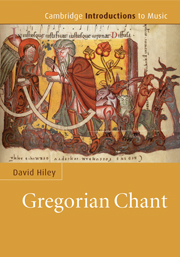Book contents
- Frontmatter
- Contents
- List of illustrations
- List of musical examples
- Note on the musical examples
- List of tables
- List of text boxes
- Preface
- Note on front cover illustration
- Chapter 1 Gregorian chant in the service of the church
- Chapter 2 The beginnings of Gregorian chant; other rites and other sorts of chant
- Chapter 3 Tradition and innovation in medieval chant: from the ninth to the sixteenth century
- Chapter 4 Thinking about Gregorian chant in the Middle Ages, and notating it
- Chapter 5 New chants for new times: from the sixteenth century to the present; aspects of performance
- Map of places from which important medieval chant manuscripts are preserved
- Chronological table
- Statistical table of chant categories by mode
- Original manuscript sources for musical examples
- Glossary
- Bibliography
- Index
Chapter 5 - New chants for new times: from the sixteenth century to the present; aspects of performance
Published online by Cambridge University Press: 05 October 2014
- Frontmatter
- Contents
- List of illustrations
- List of musical examples
- Note on the musical examples
- List of tables
- List of text boxes
- Preface
- Note on front cover illustration
- Chapter 1 Gregorian chant in the service of the church
- Chapter 2 The beginnings of Gregorian chant; other rites and other sorts of chant
- Chapter 3 Tradition and innovation in medieval chant: from the ninth to the sixteenth century
- Chapter 4 Thinking about Gregorian chant in the Middle Ages, and notating it
- Chapter 5 New chants for new times: from the sixteenth century to the present; aspects of performance
- Map of places from which important medieval chant manuscripts are preserved
- Chronological table
- Statistical table of chant categories by mode
- Original manuscript sources for musical examples
- Glossary
- Bibliography
- Index
Summary
In this chapter the historical narrative continues roughly from the point where it was left at the end of section 3.iii. We are mostly concerned here with the cataclysm of the sixteenth century and the attempted restoration of medieval chant in the nineteenth. The restoration had a practical aim, that of improving the standard of music and performance in the Roman church. But the great fund of musicological knowledge which it created also provided the foundations of modern academic chant scholarship, much of which is not concerned with the practicalities of church worship at all. At the same time, Gregorian chant has also moved outside the church, or at least been co-opted for non-religious purposes. Because of its special associations it has often been used in modern non-sacred music, for example, opera and orchestral music in the nineteenth century, film music in the twentieth, and latterly even pop music.
The final section of this book is not, however, about the modern uses of chant but offers some observations on the difficulties in performing it. For not only the notes of medieval chant had to be restored, a way of performing it had to be reconstructed – or, rather, constructed, since no ‘hard’ evidence exists about matters like medieval voice production, tempo and dynamic exists.
Chant in the age of humanism; the ‘Editio Medicaea’; neo-Gallican chant
In the early sixteenth century most of the Gregorian repertory from the early Middle Ages was still being sung.
- Type
- Chapter
- Information
- Gregorian Chant , pp. 208 - 218Publisher: Cambridge University PressPrint publication year: 2009



